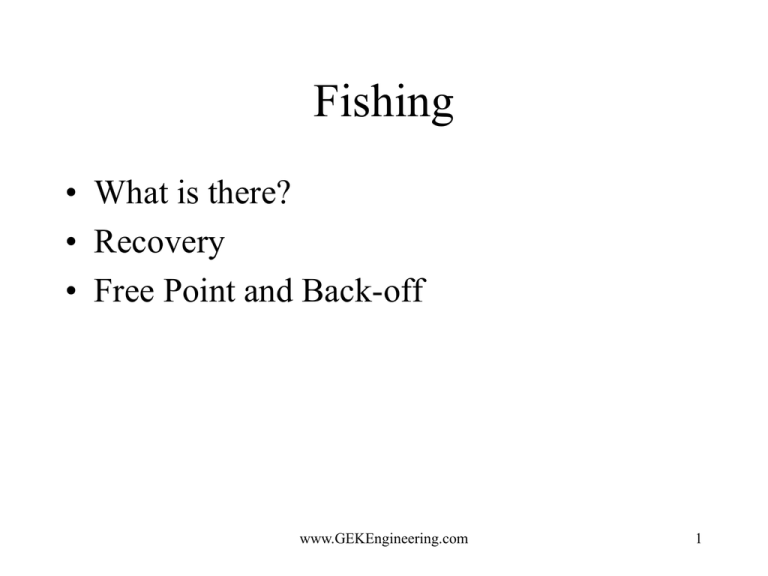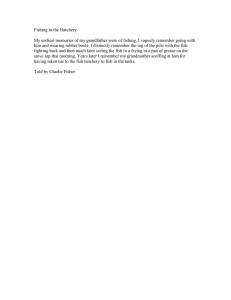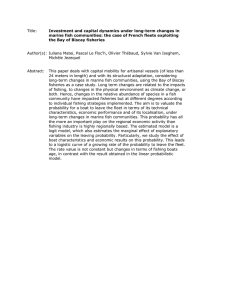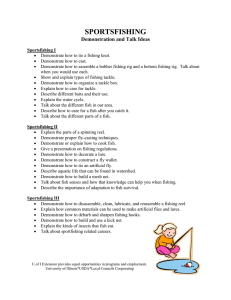Fishing cased hole
advertisement

Fishing • What is there? • Recovery • Free Point and Back-off www.GEKEngineering.com 1 Identifying the fish • • • • What is it? Where is it? What is looking up? How damaged is it? • Only when you know the answers to these questions can you devise a fishing attempt. www.GEKEngineering.com 2 The Importance of the “Tally Book” • For every piece of equipment that goes in a well, you should have: – Diameter of every body, neck, shoulders, etc. – Length of each section and the overall length. – Thread type & if pin or box will look up at each connection (many fish are unscrewed tools). – Break strength of all weak joints or thin tools – Drawing or photo of all unusual tools (place a rule in the photo) www.GEKEngineering.com 3 The Importance of the “Tally Book” • Keep the Tally book current – for every run, not changes. • Successful fishermen are planners and note takers – before the fish is lost. • Keep records of where the string drags (depth, over-pull, changes in behavior) • Compare depth readings with profile depths • Record all fluid levels, tight spots, and fill tags. www.GEKEngineering.com 4 The Importance of the “Tally Book” • When you loose a tool (and you will if you do well work for long). – Note behavior at the separation point – Tag down gently to see if the fish is stuck or has dropped (if there is a known tight spot, you may not want to tag) – Pull out of the well and carefully measure and account for all the BHA that has returned, and……. www.GEKEngineering.com 5 The Importance of the “Tally Book” • Check the recovered BHA and Compare the tools recovered with initial BHA from the Tally Book. – If the BHA is unscrewed, what is thread, and is pin or box looking up? Shoulders or smooth body present? – If BHA has broken: • • • • Does metal near the separation indicate fatigue or corrosion? Do drag marks indicate pipe collapse? Do one-sided marks or cuts hint at low side debris? Does debris on the recovered section suggest bridging? www.GEKEngineering.com 6 The Importance of the “Tally Book” • If wire is recovered without the rope socket, NEVER assume that the wire has pulled off at the rope socket. www.GEKEngineering.com 7 Tools for Examining the Fish • Impression blocks (confusion blocks?) – Flat bottom and tapered soft lead block. – Set down just ONCE! • Cameras – Continuous surface readout on E-line – Image capture (delayed updating) on E-line – Slick line conveyed, recording cameras www.GEKEngineering.com 8 Lead impression block of an obstruction in the tubing. www.GEKEngineering.com 9 Collett bent in – perhaps from CT run? www.GEKEngineering.com 10 Camera Selection • The continuous surface readout allows running at speed into a well (50 to 100 ft/min) – you can see what is coming. • Image update cameras (1 to 6 seconds screen refresh) can only be run slowly if you don’t know where the fish is – you could hit the fish and destroy the down-looking camera if run too fast. • Recording cameras, like the image update cameras, require knowledge of exactly where the fish is located. • AND - water considerations…….. www.GEKEngineering.com 11 Water for Camera Use • If water is used in the well for the camera run: – You must be able to read a newspaper through a water glass of the water that is to be pumped. – Standard field brines are not suitable for camera use, even when filtered. – A small positive water injection may be needed to sweep the wellbore during the camera run. – If the well flows, the fluid in the wellbore will become opaque quickly. – Camera movement will stir up some sediments from the pipe walls. www.GEKEngineering.com 12 www.GEKEngineering.com 13 www.GEKEngineering.com DHVI 14 ? www.GEKEngineering.com 15 Fishing and Tubing Repair • Problems • Solutions www.GEKEngineering.com 16 Typical Spear Configuration Top connection/fishing neck Catch and release mechanism Catch spring Adjustable stop www.GEKEngineering.com 17 Wireline Catching Tools “Top Hat" Spear-type wireline catchers Internal catchers www.GEKEngineering.com 18 Wireline grab and overshot. www.GEKEngineering.com 19 Wireline Fingers www.GEKEngineering.com 20 Overshot – note beveled guide area and inside grapple. Release mechanism? www.GEKEngineering.com 21 Basket – used to recover small objects www.GEKEngineering.com 22 Special tool – used for odd shapes. www.GEKEngineering.com 23 Indexing system – rotates mule shoe a few degrees by pick up and set down or by pumping, depending on mechanism. www.GEKEngineering.com 24 Spear with grapple – the grapples are interchangeable www.GEKEngineering.com 25 A wireline rasp – used for removing small amounts of soft deposits. The rasp is very hard material – don’t loose this tool in the well, cannot mill it out easily. www.GEKEngineering.com 26 Swages – right: a variety of sizes, left: a fluted swage Typical use for swages is to attempt to enlarge ovaled or partially crushed tubing. Note: the tubing can become work hardened quickly. www.GEKEngineering.com 27 Fishing With Coiled Tubing • • • • • • Load (tensile, shock, torsion?) limits jars deviation catch tools release options tubing cutoff www.GEKEngineering.com 28 Tools • • • • • • • Overshots are primary catch tool. RCJB - reverse circulation junk baskets prongs, magnets, etc., available Release sub in the string Circulation sub jars and accelerators TV camera may be best tool of all. - Know what the fish looks like! www.GEKEngineering.com 29 Fishing For Coiled Tubing • common causes of CT breaks • catch tools – continuous overshots – others??? • release mechanisms • engaging the fish • deviated wells www.GEKEngineering.com 30 Simple Overshot www.GEKEngineering.com 31 www.GEKEngineering.com 32 Causes of CT Breaks • • • • • • previous damage (point) initiated breaks present damage initiation corrosion initiation collapse tension compression? www.GEKEngineering.com 33 Catch Tools • overshots mostly - grapple? – must deal with oval tubes as a best option • continuous overshots - length limited • baiting/milling efforts – square the CT top – open the tube • rounder = better grip • wireline entry • avoid spears (outward CT radial strength?) www.GEKEngineering.com 34 www.GEKEngineering.com 35 Fishing Flattened CT • Baker continuous overshot for flattened CT – accepts collapsed CT – trap design on catch mechanism – releasing? www.GEKEngineering.com 36 Release Options • critical need - must be reliable! • must be able to release – CT limited in tension, especially in deviation – CT jars do wear out – release actuation mechanism: how?/possible? • Always plan on fishing CT in stages www.GEKEngineering.com 37 Engaging the Fish • • • • limited push with CT especially limited in deviated wells centralization of the fish milling improves engagement? – how much? • top dressing vs length milling www.GEKEngineering.com 38 Other Problems • Wireline! – Removal vs mashing it down – Condition of wireline - H2S • Has wireline been parted or is it just stuck? – Using CT with hook as a stiff leg to free wireline. www.GEKEngineering.com 39 Fishing Tools with Control Lines • RISK: The hydraulic control lines may form a birds nest in the tubing or in the BOP. On pulling the fish through the BOP, the control lines may peel back and jam between the BOP stack and fish. www.GEKEngineering.com 40 Fishing Tools with Control Lines • Initial Diagnosis: A tangle of cut and broken hydraulic control lines is on top of the tool. • To avoid problems, a shroud was designed as a full bore tool that would pass through the BOP stack to centralize and contain the control lines. www.GEKEngineering.com 41 Fishing Tools with Control Lines • The shroud leading edges scooped all the debris inside the tool body and the tool landed out on a debris gallery on the SSTT. • The fish was then speared through the top of the shroud. The fish and shroud were recovered together. The shroud gave full containment of all debris and no further junk was added to the hole. www.GEKEngineering.com 42 Deviated Wells • hydraulic centralizers • larger overshots • motor addition to fishing BHA – engagement potential increased? – jarring potential decreased? – release compromised? www.GEKEngineering.com 43 Horizontal and Deviated Well Problems • • • • Engaging Fish Pushing it to Bottom Retrieval - load study in stages Fishing under snubbing conditions www.GEKEngineering.com 44 CT Fishing in Horizontals • Problems – – – – centralization cutting beds tendency to bury fish in open hole CT limited by buckling www.GEKEngineering.com 45 Tools for Horizontal Fishing • • • • most fishing tool acceptable horizontal centralizers reverse circulation and dual CT strings anchor and piston force tools www.GEKEngineering.com 46 Buckling/Lockup of CT • Fcrit. = 2A((EIW sin O)/d)1/2 • where: – – – – – – – – A = const. 0.93 for steel E = young’s modulus, psi W = buoyed pipe wt lb/ft O = hole inclination d = radial clearance between tube and csg., in I = moment of inertia = 0.04909 (OD2-ID2) OD = pipe OD (in) ID = pipe id, in www.GEKEngineering.com 47 Max pipe or tool length that will go through a bend • L = 1/6 [R2 - (R - dd)]1/2 • where: – L = maximum tool length, ft – R = curve radius, inches – dd = ID-ODtool www.GEKEngineering.com 48 Lockup in Vertical Wells • Causes: – doglegs – tight clearances – buckled tubing/casing • Solutions – stiffer CT – straighteners – cool backside??? www.GEKEngineering.com 49 CT Jar Types • Mechanical • Hydraulic www.GEKEngineering.com 50 Jar Problems • Drag and buckling effects lessen mechanical jar effect • Hydraulic jars less effective because of flex of string (down-jar) www.GEKEngineering.com 51 CT Jar Considerations • Flow through capacity • Placement in the fishing string – above fishing tool when tool is releasable – above hydraulic release on non releasing catch tool • Directional (change internal component to go from up- to down jar) • Use with accelerator and weight stem? www.GEKEngineering.com 52 Spang Jars • Don’t work wire line on shallow problems where spangs can be across wellhead. May damage valves and if stuck, cannot close valve. www.GEKEngineering.com 53 Fishing Successes • Cased holes - goo success – – – – – – gas lift valves wireline PSI systems packers and plugs inflatables etc. • Open holes - poorer record www.GEKEngineering.com 54 Fishing • Routine Recovery: gas-lift valves, gauges, packers, plugs • Fishing: slickline, E-line, BHA’s, debris, coiled tubing, www.GEKEngineering.com 55 Fishing with CT • Best use: Where stiff , continuous motion and circulation are needed • Improvements: larger CT, hydraulic jars, low-speed, high-torque motors (limits on jar action), larger injectors • Catch tools for CT: Must take in to account the shape of the CT top (may be flattened, bent over, ovaled or necked down. www.GEKEngineering.com 56 g6.tif CT Fishing String www.GEKEngineering.com 57 g7.tif CT Fishing String No release on catch tool, but hydraulic disconnect built in above the tool. www.GEKEngineering.com 58 g8.tif Fishing String Horizontal www.GEKEngineering.com 59 www.GEKEngineering.com 60 If this string of CT was in a horizontal well, where in the wellbore would it lie? g12.tif www.GEKEngineering.com 61 Best Practices • First, run a gauge ring on slick line or CT that is slightly larger than the CT. • Consider what happens if you get onto the fish and can’t move it - release mechanism? • Fishing in large diameter hole or casing makes it difficult to engage the fish. www.GEKEngineering.com 62 Best Practices - Cutting CT • If you have to cut CT when stuck, cut it in the tubing - makes it much easier to fish. • Cut the CT with a overshot “nipper” tool that leaves a square shoulder - this allows entry into the CT. www.GEKEngineering.com 63 Deep Cuts of Stuck CT • Cut at surface, go through CT with slickline and chemical cutter – cutter must be properly sized for CT – CT needs to be in tension - free point? • Don’t pull it in two with the injector if you can avoid it. – Severed edge is necked down – Location of severed top is unpredictable www.GEKEngineering.com 64 Tools • • • • • • • Overshots are primary catch tool. RCJB - reverse circulation junk baskets prongs, magnets, etc., available Release sub in the string Circulation sub jars and accelerators TV camera may be best tool of all. - Know what the fish looks like! www.GEKEngineering.com 65 Special Case of Fishing with CT • Recovery of 9200 ft of slickline from well in Trinidad – recovered in one piece – recovered with CT www.GEKEngineering.com 66 Slickline Recovery • Slickline tool stuck at 9200 ft - slickline not parted! • Used CT - parted wire at surface and threaded it through bottom of the CT and out a side entry sub a foot above CT bottom. • Ran CT down the well until tool was encountered, pushed it loose and reeled slickline back as CT pulled out. www.GEKEngineering.com 67 Unusual Considerations • Large tool effects – – – – swab/surge clearances in profiles bending stresses and resistance wall drag (friction forces) www.GEKEngineering.com 68 Friction Reduction • Friction reducer additives can result in a 15% to 17% drop in friction force. • Use of an FR additive can drop total fraction as much at 30% when used with a CT straightener. • Stiff, small BHA’s have been carried easier through washout and tight spots. www.GEKEngineering.com 69 CT Straightner • Mechanical Device – takes out residual bend in CT - lowers frictional resistance – stresses the pipe, fatigue – use on the end 20 to 50 ft of CT where friction needs to be cut – use where CT must enter small diameter (close to CT diameter) profiles www.GEKEngineering.com 70 Friction Reducer Drawback • Formation damage increased - most good friction reducers are polyacrylamides - no breaker! • Some formations very susceptible to formation damage by any polymers or surfactants. www.GEKEngineering.com 71 CT Motors • Power increases almost exponentially with motor size. • Powering motors with straight nitrogen gas is often difficult - not enough lubrication. • Volatile oils hard on stator rubbers - use of saturated nitriles helps performance. • High temperature (400 to 500 F) motors are available. www.GEKEngineering.com 72 Motor Reliability • Surface Test of Every Motor is HIGHLY Recommended – smaller motors - tighter clearances - tight bearing packs – many new motors won’t turn – small motors are low power - 80 ft-lbs of torque? – Surface test not an absolute guarantee of downhole performance www.GEKEngineering.com 73 Motor Stalling • Small motors most susceptible - low torque • Causes – too much load on CT – load applied too quickly - motion control on injector – aggressive bits? www.GEKEngineering.com 74 Torsional Yield Strength Ty = Sy(OD4 - (OD - 2 t wall-min)4)/105.86 OD Where: Ty = Torsional Yield Strength, lb-ft t wall-min = thinnest wall, in Sy = yield strength of the CT, psi OD = CT OD www.GEKEngineering.com 75 Theoritical Torsion Strength, psi Theoritical Torsion Strength vs CT OD for 0.151" Wall Thickness 10000 9000 8000 7000 6000 5000 4000 3000 2000 1000 0 1 1.5 2 2.5 3 3.5 4 CT OD, inch www.GEKEngineering.com 76 Torque • Usually we don’t push the torque limit in workovers – need to rotate is limited – smaller motors very limited in torque • This changes in CT Drilling, especially with big motors www.GEKEngineering.com 77 Alternatives to CT for Fishing • Wireline – in horizontals? - yes • Tubing or DP – slower but more strength, control surface pressures? • Snubbing – slower, surface rotation www.GEKEngineering.com 78 Really Unusual Alternatives for Fishing • junk shots • explosives • acids none recommended with CT www.GEKEngineering.com 79 Tractors • Wireline tractors taking work away from CT-wireline in the North Sea area. • One wireline tractor was stuck - another sent down to retrieve it - successful. • SPE 38757 www.GEKEngineering.com 80 Tractors • Electric Tractors available now. • Hydraulic CT models coming? • Test facility in Aberdeen www.GEKEngineering.com 81 www.GEKEngineering.com 82 Downhole Camera view of parted pipe www.GEKEngineering.com 83 The image shows that the cones of the bit are crushed and embedded into the 9-5/8” casing at the collar. Damage to the threads where large forces were applied to move the bit can also be seen. The operator eventually milled through the bit with two concave mills Source: DHV : Downhole Video www.GEKEngineering.com International 84 www.GEKEngineering.com 85 Downhole Camera view of exploded gun? www.GEKEngineering.com 86 www.GEKEngineering.com 87 Debris in the latch mechanism of a downhole tool. www.GEKEngineering.com 88 www.GEKEngineering.com 89 Depth Effects • Fishing can be difficult at increasing depth since accelerators rely to some extent on cable/coil tension/stretch for assistance. • The best bet in this situation is to use two accelerators with short stroke "upstroke" jars (spring type) in conjunction with a heavy duty fishing cable. www.GEKEngineering.com 90 Workover Fishing Operations • Common Applications • Methods • Problems and Solutions www.GEKEngineering.com 91 www.GEKEngineering.com 92 www.GEKEngineering.com 93 www.GEKEngineering.com 94 www.GEKEngineering.com 95 www.GEKEngineering.com 96 www.GEKEngineering.com 97 www.GEKEngineering.com 98 Common Fishing Tools • • • • • Magnets Overshots Spears Wireline grabs and…. – junk baskets – bailers – the rest of the string www.GEKEngineering.com 99 www.GEKEngineering.com 100 www.GEKEngineering.com 101 www.GEKEngineering.com 102 Spear Information • Run a shoulder on all spears • Thread on fish known? - taper taps • Release feature on BHA? www.GEKEngineering.com 103 www.GEKEngineering.com 104 www.GEKEngineering.com 105 www.GEKEngineering.com 106 www.GEKEngineering.com 107 www.GEKEngineering.com 108 www.GEKEngineering.com 109 www.GEKEngineering.com 110 Oil Jars • Weak part of wireline oil jars is the head to rod connection. Breaks often leave the rod sticking up. Compress rod back into the tool and use overshot to seize the body of the tool. www.GEKEngineering.com 111 Braided Cable • • Braided cable doesn’t fatigue as much as slickline, but has to be reheaded to prevent breakage of individual strands in the rope socket. Fishing with the braided cable – can’t develop as much wire speed as with slickline but can pull much harder. Use spangs and oil jars. www.GEKEngineering.com 112 Fishing – deviated wells • Large fishing tool (overshot) problems in passing the tools around the doglegs and curves. Overshot tends to ride downward and dig out the bottom of the curve. www.GEKEngineering.com 113 Tubing Elongation delta L = (F L)/(E An) where: delta L = tube stretch, inches F = axial force on tubing, lbs L = free length of tubing, ft An = nom. x-sect area, in2 E = Young’s modulus, 30 x 106 for steel www.GEKEngineering.com 114 Determining Free Point - part 1 • 1. Pull pipe into tension with at least 500 lb of load over the hanging weight of tubing in the hole. • Make a visible reference mark on the pipe • Increase pull on the pipe in increments of 1000 lb over original tubing weight. • Measure amount of pipe stretch (delta L) www.GEKEngineering.com 115 Free Point - part 2 • Subtract original weight reading from final pull weight (FD) • Read Correct Free Point Constant (CFPC) from Table • Use Equation: www.GEKEngineering.com 116 Free Point - part 3 L = delta L CFPC / FD where: L = minimum length of free pipe delta L = stretch, inches CFPC = Free Point Constant (from table) FD = pull force, 1000 lb www.GEKEngineering.com 117 Free Point Example • Determine the minimum length of free CT when a 10,000 ft length of 1.25”, 0.087” wall CT stretches 39 inches with an applied pull of 5000 lb over tubing weight. • CFPC = 760 (table), FD = 5000/1000 = 5 L = delta L * CFPC / FD = 39*760/5 L = 5928 ft www.GEKEngineering.com 118 1.25” CT Stretch Tables CT Size 1.25 x 0.087 1.25 x 0.095 1.25 x 0.102 1.25 x 0.109 1.25 x 0.125 1.25 x 0.134 1.25 x 0.156 x-sect area 0.304 in2 0.328 in2 0.351 in2 0.374 in2 0.420 in2 0.451 in2 0.512 in2 www.GEKEngineering.com CFPC 760.0 820.0 877.5 935.0 1050.0 1127.5 1280.0 119 1.5” CT Stretch Tables CT Size 1.50 x 0.095 1.50 x 0.102 1.50 x 0.109 1.50 x 0.125 1.50 x 0.134 1.50 x 0.156 x-sect area 0.399 in2 0.428 in2 0.456 in2 0.512 in2 0.552 in2 0.629 in2 www.GEKEngineering.com CFPC 997.5 1170.0 1140.0 1280.0 1380.0 1572.5 120 1.75” CT Stretch Tables CT Size 1.75 x 0.109 1.75 x 0.125 1.75 x 0.134 1.75 x 0.156 1.75 x 0.175 x-sect area 0.538 in2 0.605 in2 0.652in2 0.745 in2 0.831 in2 www.GEKEngineering.com CFPC 1345.0 1512.5 1630.0 1862.5 2077.5 121 2.00” CT Stretch Tables CT Size 2.00 x 0.109 2.00 x 0.125 2.00 x 0.134 2.00 x 0.156 2.00 x 0.175 x-sect area 0.619 in2 0.698 in2 0.753 in2 0.861 in2 0.962 in2 www.GEKEngineering.com CFPC 1547.5 1745.0 1882.5 2152.5 2405.0 122 2.375” CT Stretch Tables CT Size 2.375 x 0.125 2.375 x 0.134 2.375 x 0.156 2.375 x 0.175 2.375 x 0.190 x-sect area 0.837 in2 0.904 in2 1.035 in2 1.158 in2 1.241 in2 www.GEKEngineering.com CFPC 2092.5 2260.0 2587.5 2895.0 3102.5 123 Working Tensile Loads of Conveyances Wireline 0.072 0.082 0.092 0.108 Working Load 720 930 1160 1827 Weight of Wire/Tube 0.014 0.018 0.023 0.031 Running Speed 100-150 ft/min CT 1.25 1.5 1.75 2.375 21900 26600 31440 49520 1.332 1.623 1.915 3.011 50-100 ft/min Tubing 2.375 2.875 3.5 57,000 79,200 119,200 4.6 6.4 9.2 5 - 15 ft/min 3-1/2" DP 189,000 15.5 www.GEKEngineering.com 124 www.GEKEngineering.com 125 www.GEKEngineering.com 126 www.GEKEngineering.com 127 Material that can unravel can be very difficult to fish. www.GEKEngineering.com 128 Surface display of a jetting sub – the problem is that energy imparted by the jet falls off rapidly. www.GEKEngineering.com 129 BHA 1 16” Cutlip Guide, Overshot www.GEKEngineering.com 130 BHA 2 17” Concave Mill www.GEKEngineering.com 131 BHA 3 11-3/4” Cutlip Guide, Overshot, www.GEKEngineering.com Short Catch Grapple 132 BHA 5 www.GEKEngineering.com 16” Cutlip Guide, Magnet 133 Fishing Tools Post-Run Pre-Run www.GEKEngineering.com 16” Cable Catcher Sub 134 Fishing Tools www.GEKEngineering.com 16” Burning Shoe 135 Fishing Tools 8”www.GEKEngineering.com x 2-3/4” Taper Tap 136 Fishing Tools 5-3/4” x 2” Spear www.GEKEngineering.com 137 Fishing Tools 4-7/8” Wireline Magnet www.GEKEngineering.com 138



